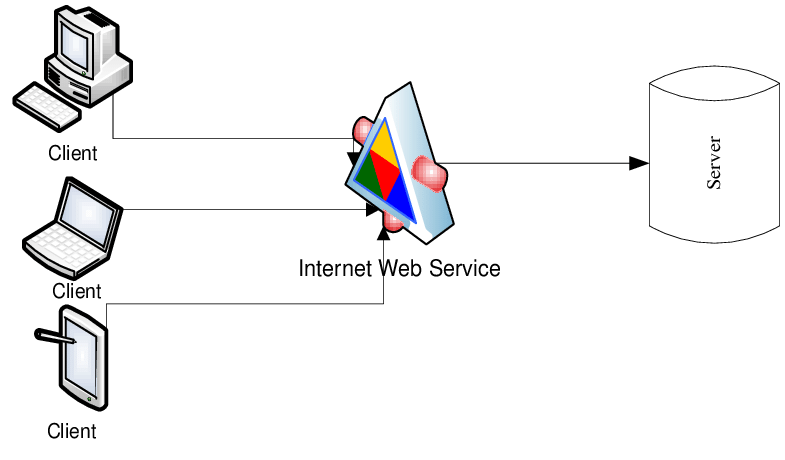The talk of the town now includes the Internet of Things (IoT), artificial intelligence, and so on. With the onset of such technologies, the world has now become more interlinked and inert-associated. The globalization brought about by such technologies has made the world a much smaller place. The client-server architecture is one such technology that helps follow a set structure of communication. This model is used for information exchange between expert systems.
Amongst the wide variety of models available, the client-server architecture is the most prominent one in use. The client-server model has had an immense impact on the progressive development of the online industry. This has further enhanced the demand for client-server based applications in the market. These applications have an indispensable role to play in information exchange between users and online industries. It is for this particular use that client-server architecture has gained its importance.
Table of Contents
The role of client and server in client-server architecture:
The client and the server are the two main parts of this computing model. The server is involved in hosting, distributing, and controlling the services and resources available for the client’s use. The client, on the other hand, demands the benefits of the centralized host. These clients are remote processors. These small processors, as they are called, try to access information from the host computer, the server.
The client computers act as an interface, allowing the user to obtain information from the central server. At this point, it is essential to note that the user doesn’t get direct access to the server. It is via these client computers that the users obtain access to services. These client computers later display the results produced for the user to view them. While the client computers display products, the servers are involved in generating the response. However, before the answer is created, the request from the client has to be accepted and processed thoroughly.
Understanding how the network works and the client-server location:
In addition to this, people should understand that the client-server architecture is a network. Just one client would not be interacting with the server. However, a line of clients from various points in the system would be trying to access server information.
Apart from this, the location of the client computers and servers also differ. The servers have to handle a massive amount of data from a range of points in the network. As a result, they are located on the most powerful machines on the network. One other reason for this is the server must be able to handle many clients at the same time. However, clients, on the other hand, are located on the less powerful workstations or personal desktops.
Also, one single client can link to more than one server at a time. With each server offering unique services to the clients, they can access information from a range of servers.
Use of client-server architecture in DBMS:
DBMS is a Database Management System. The DBMS has now become a vital part of every one of our lives today. The use of client-server architecture in DBMS is immense. For instance, imagine the current situation of lockdown due to the deadliest COVID-19 we are facing today.
In this situation, we require daily updates regarding the number of deaths due to COVID-19. The person at the server end of the network inputs these updates daily on the server. These data are then stored and maintained here in the server. On the other end of the system are the clients or users who avail of this information.
To make it more clear, those who type-specific URL for the COVID-19 death-related information are the clients. These clients are none other than the customers who consume the data to put in a more straightforward fashion.
Thus, to reinforce once again, the client and server are located in two different regions of the globe. However, they might also be situated in the same premises.
Finally, users can now type the specific URL, for instance, the link to WHO or CDC or Health Ministry. And get access to the necessary death-related information regarding COVID-19 or other disease-related data that they want.
The language features of client-server architecture:
- This language used by the client-server architecture web is a protocol that may seem gibberish to us. This is exclusively for the two systems involved in interaction and can only be understood by them.
- The most well-known amongst these languages include HTTP and HTTPS. HTTP stands for HyperText Transfer Protocol. While HTTPS, on the other hand, is HyperText Transfer Protocol Secure.
- A specific structure of formatted data is followed for the protocol used by the client to request data. The most commonly used formats include XML and JSON.
- For those who do not know, XML stands for Extensible Markup Language, and JSON is JavaScript Object Notation.
- The server generates the required response in this particular structured format, which is usually XML and JSON.
- The interpreters used are mainly DOM and CSS interpreter. Don’t get scared by the numerous abbreviations that have been used here. To make it more explicit, DOM stands for Document Object Model, and CSS is Cascading Style Sheets. CSS is a programming language that you might have heard before.
- The process of interaction between the server and the browser also involves the JS Engine. This is also known as JIT, which stands for Just in time. It is because of these JIT compilers that the client receives instant replies when they search on servers.
Types of client-server architecture:
-
1-tier architecture:
This is the initial and the most specific category of client-server setting. In this type of architecture, all the different components for a technology reside on a single platform. The client, server, and database are all present in the same system. One example of software that consists of layers within an available package is MS Office. This is the most direct way of accessing data. The MP3 player also comes under this. So next time, when you play a song using the coding format MP3 player, remember its 1-tier architecture.
-
2-tier architecture:
This type of architecture is similar to the client-server application. In this type, communication between the client and server takes place without any intermediate. It is a natural form of communication.
If the client computer handles the business logic and data logic, it is termed fat client thin server architecture. However, if the server collects business logic and data logic, it is termed light client fat server architecture. 2-tier architecture enhances the speed of communication.
-
3-tier architecture:
It protects 2-tier architecture. Although this type of architecture is easy to use, it is not affordable.These three components include:
- Client Tier- Presentation Layer
- Business Tier- Application Layer
- Data Tier- Database Layer
This type of architecture is also the most well-known DBMS architecture amongst all those explained. It further serves as an extension of the 2-tier architecture system. To give you a bit more details regarding the three layers-
- The presentation layer includes your desktop, tablet, mobile phone, or personal computer.
- The application layer includes the server.
- And the database server involves the database system.
Thus, all the different types of architecture are essential for the maintenance and design of a database system.
The n-tier architecture includes:
- Logic tier
- Presentation tier
- Data-tier
Advantages of client-server architecture:
- One of the main advantages is that it is similar to getting everything under one roof. That is, all data is found within one single place. In addition to this, this is a centralized system of the network.
- That, too, within a short period. This makes this web highly helpful, particularly during times of crisis.
- Apart from this, the client-server architecture is also highly cost-effective. This makes it affordable to all, particularly to those having a lower economic background. Even they can get access to the web.
- The cost of maintenance is also comparatively less. This makes it even more applicable to low income earning groups and others too.
- The handling ability of the client and server can also be modified uniquely.
Disadvantages of client-server architecture:
- One of the most notable disadvantages of client-server architecture is that the client is susceptible to viruses. Not just to viruses, but also worms or Trojan horses. The two main ways in which the client computer could be destroyed by virus attack include:
- Firstly, if the virus is already present in the server, it will enter from the server to the client.
As shown above, in both cases, the virus enters the client from the server. However, here is the difference to help you understand it better. In the 1st case, the virus is directly present in the server. While in the 2nd case, it is uploaded into the server from an external source.
- Like how the clients are prone to viruses, similarly, the server is susceptible to Denial of Service (DOS) attacks.
- Chances of spoofing and modifications during transmission are also high in the client-server architecture computing model.
What attracts businesses towards client-server architecture?
The drastically booming market and business competition is forcing online businesses to look out for the best internet services. It is not just the inter-company competition but also the intra-company competition that is driving businesses towards this.
Industries ranging from big to small all have now moved towards using the client-server architecture, for developing applications. The most impressive thing about client-server architecture that is attracting all is the quality client-server communication it provides.
There has been a dramatic change in people’s lifestyle. People have shifted towards a digitized world. This shift and digital transformation is further attracting hi-tech customers towards the interactive software applications. For instance, all the e-commerce websites of today are client-server architecture based.
In the client-server architecture based e-commerce, the client is an application that sends request to the server. The client makes use of a Graphical User Interface (GUI) for getting access to the services provided by server. This is just to give you an idea about how the client-server architecture based e-commerce websites work.
FAQ:
- What are the components of client-server architecture?
The characteristics include a front-end client portion and a back-end server portion.
- What are the various types of servers?
The most common ones refer to client servers, collaboration servers, application servers, open source servers, proxy servers, FTP and list servers.
- What do you mean by CORBA?
CORBA is Common Object Request Broker Architecture is a standard for communication between different systems.
- What is Remote Data Management?
The application involves the client and a data management system which is present on a remote server.


